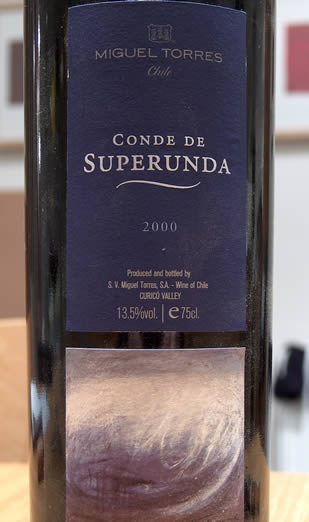|
Extended
tasting note 12
Miguel
Torres Conde de Superunda 2000 Curiců, Chile
 What
is it about Chilean wine? Blind tasting is usually a difficult sport,
but itís rare that I blind taste a Chilean red wine without spotting
its country of origin fairly quickly. And while inexpensive Chilean
redsópacked full of pure, bright fruitóhave been hugely successful
commercially, Chilean fine wine hasnít really done it for me.
Theyíve usually tasted like riper, more concentrated versions of
cheap Chilean wines, offering sweet fruit but little in the way of
complexity. Iíve nurtured this sneaking suspicion that Chilean wines
taste worryingly alike. What
is it about Chilean wine? Blind tasting is usually a difficult sport,
but itís rare that I blind taste a Chilean red wine without spotting
its country of origin fairly quickly. And while inexpensive Chilean
redsópacked full of pure, bright fruitóhave been hugely successful
commercially, Chilean fine wine hasnít really done it for me.
Theyíve usually tasted like riper, more concentrated versions of
cheap Chilean wines, offering sweet fruit but little in the way of
complexity. Iíve nurtured this sneaking suspicion that Chilean wines
taste worryingly alike.
But Iím an open-minded sort of guy, so tonight I
opened a high-end Chilean red from Miguel Torres Chile: Conde de Superunda 2000 Curiců. The distinguishing feature of this
wine is the varietal composition. As well as the usual Chilean fare of
Cabernet Sauvignon and CarmenŤre, we have Tempranillo and Monastrell
(MourvŤdre). All aged for a couple of years in French (Nevers) oak.
As youíd expect, this is a deep, dark-coloured wine.
Iím drinking it out of a Riedel Burgundy glass, and itís 9.40 pm
on a Wednesday evening. My goal until bedtime is, in addition to
writing this note, to make a bit of progress with one of my Express
columns, and also a chapter for my closures book. The wine will aid my
creativity, or send me to sleep Ė one or the other. Wine writing is
one of the few occupations that can be done glass in hand without a
loss in productivity. (The assumption, here, is that one doesnít
neck a whole bottle in 20 minutes, in which case work quality is
likely to be compromised.)
Back to the wine. I like the nose. Thereís the
trademark sweet, pure, blackcurrant fruit pastille character, but as
well as this Iím getting some exotic spices and perhaps a hint of
minerality, too. Itís quite fresh, with just a hint of supple
greenness. Pure fruit plus greenness is, of course, one of the
defining features of the Chilean red wine style. Itís not too
obvious here. The palate is quite structured and savoury, providing
ample support to the sweet fruit. Good concentration, with some dark
chocolate notes and a little bit of plummy bitterness. Thereís still
a lot of pure fruit here, but itís not overly sweet, and the spicy
oak is very much in the background.
Thereís no getting away from the fact that this is a
new world wine in quite a modern mould. It still tastes Chilean, which
Iím not saying is necessarily a bad thing. But with this new world
character we have admirable structure and restraint. At age 6, this is
a wine that still tastes quite primary, but I reckon if you look hard
you can spot some spicy complexity coming through Ė perhaps over the
next year or two this wine will begin to open out nicely. I also think
that this is a wine with a future ahead of it, and in five years to a
decade it will be singing. These projections are, of course, no more
than educated guesswork. But Iím getting quite a good feeling about
this bottle.
Iím fairly sure that this is the most serious Chilean
wine Iíve yet tasted. Iíve done quite a few high-end Chileans, but
this is a bit more understated, complex and balanced than the others.
The alcohol level, 13.5%, is pretty sane, too. Itís hard to rate: I
guess what Iím saying is that while Iím enjoying it, it isnít
really my style of wine. I like it but I donít love it. But if you
are more favourably disposed to the Chilean style, then this wine
might well be the business, for you. If Iím pressed to give it a
score, Iíll say 91/100.
Wine tasted 03/06
Find
this wine with wine-searcher.com
GrŁnhaus;
Roc des Anges; Gaillard;
Veratina; Arturo;
Wynns; Drystone;
Foundry and Columella; Meruge;
Foillard Morgon; Clonakilla
Back to top
|

